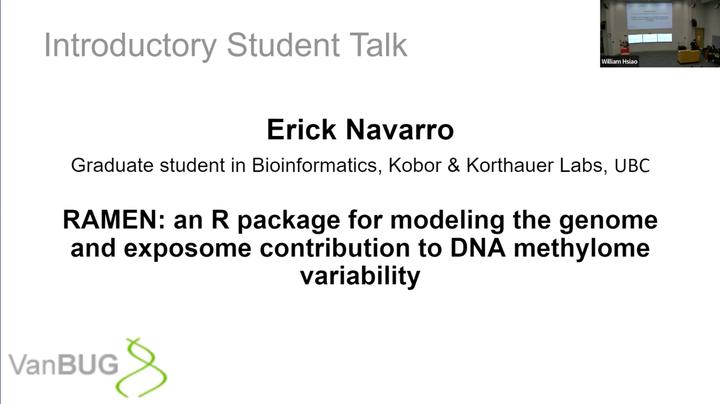RAMEN - an R package for modeling the genome and exposome contribution to DNA methylome variability
 Image credit: VanBug
Image credit: VanBug
Abstract
This talk features my work followed by a presentation of my supervisor Dr. Korthauer, who further details the research that is carried out in our lab. DNA methylation (DNAme) is an epigenetic mark that can regulate the genome, and its variability has been associated with phenotypic changes. Studies in birth tissues suggest that genetics (G) and environmental (E) factors jointly better explain DNAme variability in most of the newborn epigenome (75-89%). However, limitations of previous works are that the prenatal environment has been represented by a small set of variables (<20). Furthermore, past methodologies can be improved by clustering proximal DNAme sites into regions that exhibit high chances of working as units, taking into account the design of the DNAme microarrays, and implementing embedded variable selection methods. Our current study addresses these gaps and estimates the contribution of G and E to DNAme variability at birth. Using cord blood samples of CHILD, a comprehensively characterized and geographically diverse Canadian cohort (n=712, 92 E variables), we aimed to 1) identify Variable Methylated Regions (VMRs) which consist of two or more highly variable and correlated probes < 1kb apart or of highly variable probes with no nearby measured CpG in the array, and 2) analyze the association of VMR DNAme levels with G across cis SNPs ≤ 1 Mb apart and E across four main dimensions of the prenatal environment (parental psychosocial, maternal health, built environment, and maternal nutrition). Our work highlights the role of G in DNAme and the importance of addressing it in epigenetic association studies jointly with environmental exposures. Furthermore, we developed an R package: Regional Association of Methylation variability with ENvironment and genotype (RAMEN; github.com/ErickNavarroD/RAMEN), which provides the community an easy-to-use pipeline to replicate our methodology in other cohorts and reproduce our findings.